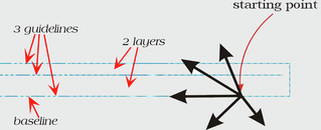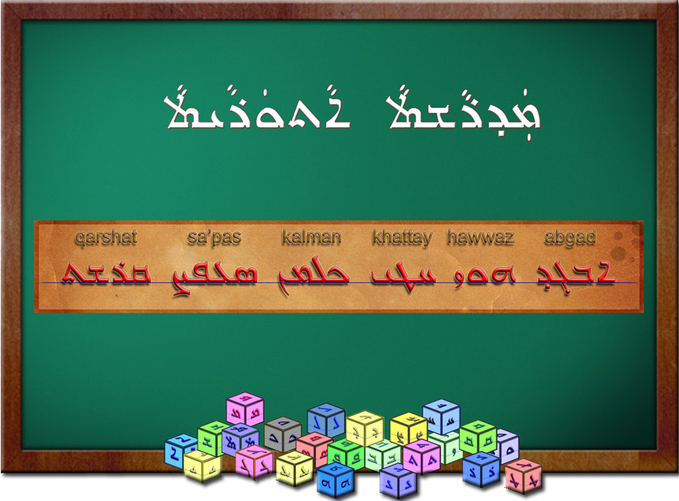—This page: KINDERGARTEN--
The basics:
base line, starting point, guide lines, strokes
The letters in the Assyrian alphabet are built with lines—some straight and some curves, and points. A line could be solid straight or it could be broken in two-three pieces. As long as the pen continues to draw and keeps contact with the paper, the pieces are considered a part of one line. Each line is called a stroke.
Base Line, Guide Lines, Layers

Base line, 3 guide lines, 2 layers, Illustration 1
The Base Line is a thin line, imaginary or drawn on the writing surface where over it we do the writing (Illustration 1).
Besides the Base Line, there are two more lines called Guide Lines above it where the letters fit.
A Layer is an area between two Guide Lines where the letters fit. In illustrtion 1 the Base Line, two other Guide Lines and the two Layers are demonstrated.
Basically, the alphabet is written between the three Guide Lines (Base Line is one of the three a Guide Lines) or between the two Layers.
Besides the Base Line, there are two more lines called Guide Lines above it where the letters fit.
A Layer is an area between two Guide Lines where the letters fit. In illustrtion 1 the Base Line, two other Guide Lines and the two Layers are demonstrated.
Basically, the alphabet is written between the three Guide Lines (Base Line is one of the three a Guide Lines) or between the two Layers.
Starting PointNote: During my teaching career in Tehran, I came up with the idea of the Starting Point.
"The Starting Point", is an imaginary point on the base line where we start writing the letters. The first stroke of the characters is drawn starting from the Starting Point. From this point, we draw our line to the left, up or down--not horizontally to the right. (Illustrations 1, 2) |
Illustration 2
|
the Exception
There is an exception to this rule, and that, ironically, is the first letter—allap. The second stroke of the letter allap starts from the top and ends at the end of the first stroke, versus the above rule where the strokes start from the starting point and go up high, below or to the left. More about this in "1st. Grade/Abgad".
Three Guide linesThe general rule that Mr. Issa Benyamin has thoroughly explained in his book:
"The Assyrian Calligraphy", is that our letters are drawn in seven layers (shweeyati). For the purpose of making the lessons simple, I have simplified them into two layers or three Guide Lines (Illustration 3). The letters basically are written in lower two lines—in the lower layer. A few letters have strokes extending to the top line, and some below the base line. |
Stroke
The term "stroke" refers to how many times we lay the pen (or pencil) on the paper and pick it off the paper to draw a particular part of the letter.
Some letters are drawn with a single stroke, some with 2 or more strokes. For example, in English,
the letters "c", "e", "l", "m" and "n" are written with one stroke,
the letter "i", "p", "Q", "t" and "x" are written with two strokes,
and the letters "F" and "H" are written with three strokes.
We will discuss how many strokes the Assyrian letters have in a little while.
Some letters are drawn with a single stroke, some with 2 or more strokes. For example, in English,
the letters "c", "e", "l", "m" and "n" are written with one stroke,
the letter "i", "p", "Q", "t" and "x" are written with two strokes,
and the letters "F" and "H" are written with three strokes.
We will discuss how many strokes the Assyrian letters have in a little while.
The Exercise for the Starting Point
Draw lines to different directions as shown in illustrations 1, 2 and in this short movie. Fill the page with this exercise. Play the above video to get a better idea.
Home | 1st Grade | Bazaar | Contact Us
<< previous page: Home … next page: PDF Starting point >>
© Copyright 2010 Atuta Assyrian School. All Rights Reserved.
<< previous page: Home … next page: PDF Starting point >>
© Copyright 2010 Atuta Assyrian School. All Rights Reserved.


